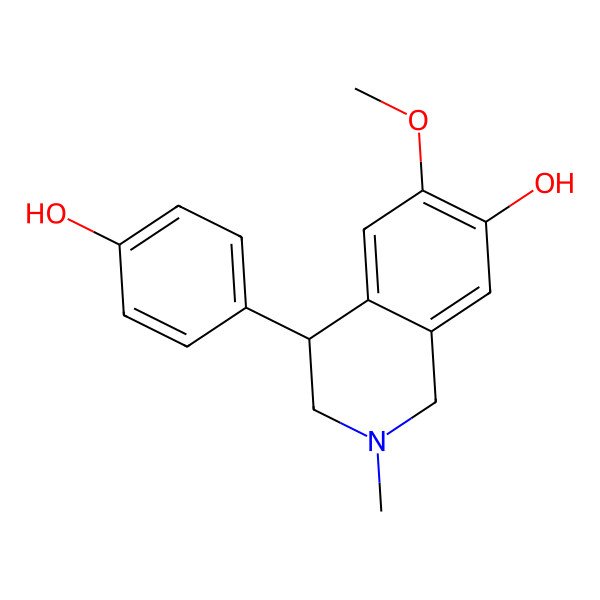Cheryline
| Internal ID | 380f3644-f392-43a8-bb22-4a58281ba83c |
| Taxonomy | Organoheterocyclic compounds > Tetrahydroisoquinolines > 4-phenyltetrahydroisoquinolines |
| IUPAC Name | 4-(4-hydroxyphenyl)-6-methoxy-2-methyl-3,4-dihydro-1H-isoquinolin-7-ol |
| SMILES (Canonical) | CN1CC(C2=CC(=C(C=C2C1)O)OC)C3=CC=C(C=C3)O |
| SMILES (Isomeric) | CN1CC(C2=CC(=C(C=C2C1)O)OC)C3=CC=C(C=C3)O |
| InChI | InChI=1S/C17H19NO3/c1-18-9-12-7-16(20)17(21-2)8-14(12)15(10-18)11-3-5-13(19)6-4-11/h3-8,15,19-20H,9-10H2,1-2H3 |
| InChI Key | VXXVFIKKBBVGIR-UHFFFAOYSA-N |
| Popularity | 10 references in papers |
| Molecular Formula | C17H19NO3 |
| Molecular Weight | 285.34 g/mol |
| Exact Mass | 285.13649347 g/mol |
| Topological Polar Surface Area (TPSA) | 52.90 Ų |
| XlogP | 2.50 |
| VXXVFIKKBBVGIR-UHFFFAOYSA- |
| VXXVFIKKBBVGIR-UHFFFAOYSA-N |
| 2-Methyl-4-(4-hydroxyphenyl)-6-methoxy-7-hydroxy-1,2,3,4-tetrahydroisoquinoline |
| 4-(4-Hydroxyphenyl)-6-methoxy-2-methyl-1,2,3,4-tetrahydro-7-isoquinolinol # |
| InChI=1/C17H19NO3/c1-18-9-12-7-16(20)17(21-2)8-14(12)15(10-18)11-3-5-13(19)6-4-11/h3-8,15,19-20H,9-10H2,1-2H3 |

| Target | Value | Probability (raw) | Probability (%) |
|---|---|---|---|
| No predicted properties yet! | |||
Proven Targets:
| CHEMBL ID | UniProt ID | Name | Min activity | Assay type | Source |
|---|---|---|---|---|---|
| No proven targets yet! | |||||
Predicted Targets (via Super-PRED):
| CHEMBL ID | UniProt ID | Name | Probability | Model accuracy |
|---|---|---|---|---|
| CHEMBL3251 | P19838 | Nuclear factor NF-kappa-B p105 subunit | 98.76% | 96.09% |
| CHEMBL3192 | Q9BY41 | Histone deacetylase 8 | 92.74% | 93.99% |
| CHEMBL225 | P28335 | Serotonin 2c (5-HT2c) receptor | 92.61% | 89.62% |
| CHEMBL2581 | P07339 | Cathepsin D | 92.22% | 98.95% |
| CHEMBL5619 | P27695 | DNA-(apurinic or apyrimidinic site) lyase | 91.50% | 91.11% |
| CHEMBL3438 | Q05513 | Protein kinase C zeta | 90.67% | 88.48% |
| CHEMBL5608 | Q16288 | NT-3 growth factor receptor | 89.76% | 95.89% |
| CHEMBL2056 | P21728 | Dopamine D1 receptor | 89.49% | 91.00% |
| CHEMBL2041 | P07949 | Tyrosine-protein kinase receptor RET | 89.19% | 91.79% |
| CHEMBL4261 | Q16665 | Hypoxia-inducible factor 1 alpha | 88.84% | 85.14% |
| CHEMBL3137262 | O60341 | LSD1/CoREST complex | 88.01% | 97.09% |
| CHEMBL3108638 | O15164 | Transcription intermediary factor 1-alpha | 87.90% | 95.56% |
| CHEMBL1907603 | Q05586 | Glutamate NMDA receptor; GRIN1/GRIN2B | 87.14% | 95.89% |
| CHEMBL3060 | Q9Y345 | Glycine transporter 2 | 86.11% | 99.17% |
| CHEMBL2535 | P11166 | Glucose transporter | 85.82% | 98.75% |
| CHEMBL4208 | P20618 | Proteasome component C5 | 85.59% | 90.00% |
| CHEMBL4203 | Q9HAZ1 | Dual specificity protein kinase CLK4 | 84.22% | 94.45% |
| CHEMBL1293249 | Q13887 | Kruppel-like factor 5 | 83.25% | 86.33% |
| CHEMBL241 | Q14432 | Phosphodiesterase 3A | 83.11% | 92.94% |
| CHEMBL2635 | P51452 | Dual specificity protein phosphatase 3 | 81.38% | 94.00% |
| CHEMBL5852 | Q96P65 | Pyroglutamylated RFamide peptide receptor | 81.08% | 85.00% |
| CHEMBL5469 | Q14289 | Protein tyrosine kinase 2 beta | 80.11% | 91.03% |
Below are displayed all the plants proven (via scientific papers) to contain this
compound!
To see more specific details click the taxa you are interested in.
To see more specific details click the taxa you are interested in.
| Crinum bulbispermum |
| Crinum latifolium |
| Crinum macowanii |
| Crinum moorei |
| Narcissus poeticus subsp. radiiflorus |
| PubChem | 618047 |
| NPASS | NPC115870 |
| LOTUS | LTS0052602 |
| wikiData | Q105298827 |